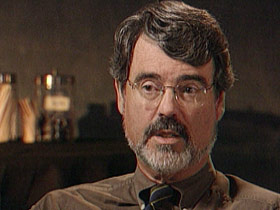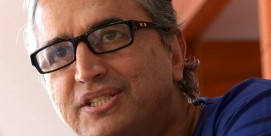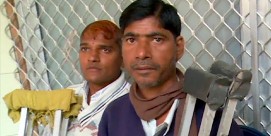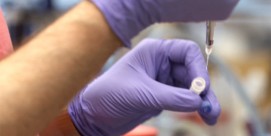In This Episode << SLIDE LEFT TO SEE ADDITIONAL SEGMENTS
Dr. Fitzhugh Mullan Extended Interview
Read excerpts from R & E’s interview about health care ethics with Dr. Fitzhugh Mullan, a pediatrician at the Upper Cardozo Community Health Center in Washington, D.C., clinical professor of pediatrics and public health at George Washington University, editor of the health policy journal HEALTH AFFAIRS, and author of BIG DOCTORING IN AMERICA:
On the rise of specialists:
The latter half of the twentieth century saw American physicians moving briskly away from general practice and primary care toward specialty medicine. This was driven a lot by science. We have more that we know now, and that’s more precise and more demanding. So specialization is a great asset and an important facet of our system.

But at the same time, those physicians who care for the individual in a complete sense, who’re responsible for coordination and continuity — the generalist — used to be the general practitioners, the GP. Today, it’s the family physician, the general internist, the pediatrician. They’ve fallen to the back of the pack. They’re less prestigious. They’re paid roughly half of what specialists are paid, and medical students tend not to desire those careers in great numbers.
That is a problem, and as science continues to move ahead — as it will — that is going to be an even greater problem. The hazard, of course, is that the medical profession will become fractured into multiple enclaves of highly technical, highly competent, but essentially ill-coordinated specialty camps. And as customers of the health care system, all of us want and very often need folks who can put things together, who can coordinate when we have multiple illnesses, as we often do — when we have problems that aren’t strictly medical but are psychosocial in nature that fit into health care.
The generalist in American health care is a very, very important player who gets very little press and very little attention and relatively little positive reinforcement these days. That’s a big problem.
That phenomenon is nationwide. Now, folks who are the least economically able, who either have no health insurance or have Medicaid or minimal entree into the system — what is needed by all of us, and certainly what is needed by disadvantaged folks in America is primary care. You need your basic health care, and that is primary care. In impoverished communities, whether they’re inner-city communities or rural communities, the relative lack of primary care provision cuts particularly hard. That’s the floor that we’ve got to put under everybody.
Frankly, in the better-to-do sectors of America, we have problems in this regard, as well. A system built around specialty care is, by definition, expensive. A system built around primary care, with good generalist provision and specialty referral as necessary, is far more efficient and economical. And we have huge problems with costs in America. In our well-to-do sectors we devalue and fail to build in the primary care we need. That reflects in cost escalation and, frankly, a lot of dissatisfaction for patients who can’t find a good doctor, which usually means they can’t find someone to put it all together.
On doctoring:
By “big doctoring” I mean individuals who are equipped to embrace the human condition. They’re prepared scientifically and by personality to deal with the variety of problems that people present with.
There is a struggle, an intellectual, conceptual struggle between people who are generalists, who know a lot about a variety of things but, necessarily, not in great depth, and specialists, who know a great deal, but in a very limited area. Both have valuable roles to play in health care, as in many other walks of life. You can have a highly refined tax consultant and a highly refined banker; but sometimes you need just a general estate planner who can help you figure out how to put things together. The generalist-specialist tension can be found throughout society.
The march of science, the incredibly valuable and fascinating biological phenomena that we are little by little uncovering, create a call for specialization — people who [bear] down on various things we find within the human genetic code, for instance, or with greater knowledge of neuroscience.
The problem is when that gets out of hand, and when the medical profession calibrates itself largely to provide practitioners of these highly specialized arts and forgets about the importance of the floor that resides under all of us, which is the generalist capability. In failing to value that, a number of things happen. We don’t educate people for it. These values are not apparent to young people in medicine or health care. We don’t reimburse it. We pay people more poorly when they go into the generalist disciplines than when they become proceduralists, who are highly competent in a small range.
People become entertained with the highly refined, highly glitzy interventions that specialists can carry out. “Glitzy” is too trivial; I mean, these things are very important, but they’re also often more easily dramatized than providing good immunization, good prenatal care, good care to people with depression.
A number of things make a specialty practice attractive and leave those of us who are practicing, or teaching, or advocating for the generalist disciplines with a steep hill to climb.
Medical students — no matter how idealistic — have at least one eye on the economics of their future. Virtually all medical students leave school with debt. The average indebtedness of medical students these days is approaching $100,000. And when one looks down the road, you don’t have to have a doctorate in economics to figure out that if you’re a plastic surgeon or an orthopedic surgeon, or a cardiologist, you’re going to make a whole lot more than if you’re a family physician or a pediatrician. That factors into people’s decisions, and medical students are human beings. And that is something that I can’t gainsay them.
However, we’ve structured a system that says somebody who does something that’s highly refined, often in a highly repetitive way — ophthalmologists who do cataract surgery day after day — that’s fabulous surgery, but it’s a very limited domain. We value it and pay them $500,000 a year. With your family physician, one patient has depression. The next patient has HIV disease. The next patient needs immunizations. The next patient has an alcoholic spouse. Each one of those calls on a whole different set of capabilities. Very complicated, very difficult. We pay that person a fifth what we pay the ophthalmologist who’s doing the same thing over and over again. This isn’t to say that isn’t a valuable and highly skilled discipline, but we’ve tilted the field against the generalist. And that’s a big problem, because it replicates itself. Once the field’s tilted, people go in the direction of gravity. They go where the money is.
On government’s role:
Much of medical pricing is based on Medicare reimbursements, which are set as part of a national Medicare program. While limited efforts have been made to balance between what is reimbursed for people who do procedures — that’s where the big money is — and people who don’t do procedures — that is, internists and pediatricians and family physicians who, by and large, talk and write prescriptions — there have been efforts to equalize, but those efforts have been modest. We need to equalize far more the reimbursement, and the only national reimbursement is Medicare. Medicaid follows on that somewhat. Those are the two national [re]imbursement programs.
We do not have among all the very important research institutions of government — mostly at the National Institutes of Health — a National Institute of Primary Care Research. We do not have a National Institute of Family Medicine Research, for instance. We have a Nursing Institute and an Arthritis Institute and a Cancer Institute. There’s a great deal that could be done to improve our knowledge base in the area of primary care, and having a research enterprise there would be important.
In terms of scholarships and support for medical school, a great deal more could be done. The National Health Service Corps pays scholarships for individuals to go to underserved areas in primary care. It is a good program, but it’s small. They give away maybe 500 scholarships a year. There are 16,000 medical students, many more of whom would take these scholarships.
Nurse practitioners and physician assistants are important nonmedical, nonphysician providers. Programs for them would be another very important activity. Reimbursement, research, and student support are three important areas.
Role modeling and teaching young people in medicine and nursing in primary-care settings, particularly in underserved communities, is very important to the selection process for people going along through medicine, through nursing and picking careers. Teaching and training programs in community health centers, in rural health centers, in the Indian Health Service and the like are very important. A modest amount of that goes on. The government funds maybe $100 million of that. They put billions of dollars into other kinds of support for medical education and academic health centers, but very, very little ($100 million sounds like a lot; divided across the country and all the students it is very little) in this area. Teaching and training, and support for teaching and training in primary care, in underserved areas is a very important area that we could do a lot better in.
On the impact of managed care:
All care has to be managed. There is a finite health-care dollar. With few exceptions, we don’t have enough money to buy everything we’d like in the health arena. And over time, we’re going to have to learn to live with[in] our budget. Managing care, which means making intelligent choices about how we spend our health-care dollar, is an important concept.
The managed care companies and various manifestations of medical care over the last number of years have often been ham-handed; and many people have had bad experiences, and managed care has developed a bad reputation. The idea is a good one, an important one. Managed care, early on in many of the plans, chose primary care as a very important, central element for what it was doing, because it has been proven to be efficient. It’s been proven to be effective moving patients between specialists and generalists, and using the dollar intelligently, and providing good prevention and good, long-term health care.
Because many companies chose primary care, and then people began to dislike managed care, primary care has suffered collateral damage from the public’s reaction to managed care. The two ideas need to be seen as separate. They are not by any means the same. Primary care is terribly important. Figuring out how to manage care, live within our health care budget, and provide care equitably to all of our citizens remains an unmet part of the American agenda, so that some form of managed care is going to be essential. Some form of managing care is going to be essential to having fair and effective health care for all of our population.
On human healers:
The horse-and-buggy physician is a powerful image out of our past. The idea was that this was a caring person who rode out in the night, in the rain, and came to your bedside and healed you. It’s an important image. It probably is a bit fictitious. Surely, there were people who did that. Their science was certainly very limited. Their effectiveness was probably pretty minimal.
We have come a long way from that to what healers can do. A lot depends upon laboratories and imaging and a variety of things that don’t transport easily to the home. We have become very effective in training people at the scientific side of medicine. Along the way, however, the healing hand, symbolized by the physician riding out in the night to sit by a bedside, has tended to get pushed aside — sometimes forgotten about altogether. Part of teaching medicine and part of the good practice of medicine today is the array of scientific information and capabilities that we have, which require mental discipline, having healers — physicians, nurses, and others — whose attitude remains high-touch; the caring side, the healing side of what they’re doing is ever present in their mind. In the midst of a busy day, with the lab slips and insurance forms that dog us all, they can keep the human side in their priorities and high in their minds as they go about their work. It’s not easily done. It is sometimes forgotten, but it is a very, very important part of our mission in medicine.
On the future of medical care:
The principal struggle is between what I call “big doctoring” and what might be called “fragmented doctoring.”
If we have a system built on big doctoring — the concept that there are general practitioners who practice primary care, who take responsibility for individuals over time, for whom care is comprehensive, and who coordinate the use of specialists, hospitals, and diagnostic techniques — we will build a system that has both a very human side to it, that uses science and technology intelligently, and that is in a position, from a cost point of view, to provide care to the entire population.
At the other end of the spectrum, we will be looking at the care of individuals largely by specialists. I call it the “food mall approach.” You walk in and say, “Well, today I feel like Chinese. Well, no. I think I’ll go have the fajitas. Well, no. I’ll go over there have a little bit of salad bar.” “Today I feel like I got a skin rash. I’ll go see the dermatologist. Tomorrow I’ll go see…” and people say, “That’s fine. We’ll have the Internet that will pull it all together.”
Well, the Internet’s a very powerful tool and will affect medicine, medical care, and the interrelationship between patients and clinicians. But it’s not the answer to a human being who needs to be at the center of a system that will be efficient and humane.
The tension in the future will be whether we can pull back and get perspective and say we want to build a system that is based on primary care and has a good and effective and democratic use of resources. Or, will we have one that’s highly fragmented, where people will be wandering from specialist to specialist, each practicing very effective, very limited, and very costly care, with little coordination and no continuity?
The consumer is far more empowered today than 30 years ago, 20 years ago, ten years ago, and will continue to be more empowered — at least certain kinds of consumers: those of us who are computer-literate and who like to do self-management. And that will be a substantial part of the population.
Even with all that going for an individual — and that is not by any means the whole population, there are many life circumstances, there are many clinical circumstances that require the integration, the coordination, counseling, and navigation that you really need a good doctor to help you with — somebody who knows the system, knows the diseases, knows the specialists and can help you decide, “Do I need to see a specialist for this? Do I need to go into the hospital for this? Do I want to go for further chemotherapy, or do I want to take the hospice route?” These kinds of life decisions all along the spectrum of health care require someone who knows you, who knows the system.
Valuing and putting those kinds of people at the center of the system is very, very important. It worries me that we have what I call “genome fever,” the belief that, as we unravel the human genome and begin to harvest the information from that, we’re going to have rifle-shot specialists who are going to be able to fix this problem with a single, diagnostic treatment or a single intervention — and then, by the way, “I’ll live forever.”
That really doesn’t take into account our complicated human body — which, by the way, has a mind and a spirit associated with it that requires complex care at many points along the way. That’s the kind of doctor that we’re talking about needing.
On medical care for people in rural areas:
The whole set of problems associated with the distribution of doctors in America is troublesome and not getting any better — some would argue it is getting worse. Urban areas have been magnets for physicians, who tend to be urban to begin with and who are trained in an urban way. Many people become reliant on the medical culture and the technologies that are urban-based, and the idea of practicing in a rural area is unattractive to them either personally or because they feel they can’t practice their discipline without a good backup and collegiality. All of those are real problems; they are not fictitious.
What we need to do is design a system of care that has the kinds of incentives and strategies in it that will keep and bring doctors and other providers to rural areas. There’s good evidence that doctors and nurses recruited from rural areas have a higher likelihood of returning there. So with our doctors and our nurses, making sure many come from rural areas. We need to do training in those areas, whether it’s rural or inner city, for the purpose of modeling and mentoring people. We need incentives. The National Health Service Corps and other kinds of programs that provide scholarship assistance and loans have been good at getting doctors into rural areas, not always but sometimes keeping them there. In some cases, we’re going to see rotations of doctors every number of years, and we have to support that. We can’t assign people to rural areas in perpetuity, if they’re not happy there. We’ve had very modest pay differentials under Medicare, the only national program we have that favors rural doctors. These have been a few percentage points’ increase in your reimbursement if you work in a rural area. We could do a great deal more to make rural practice economically appealing.
Recruitment, training programs that emphasize rural medicine, reimbursement incentives and, finally, the advent of telemedicine. The Web and the Internet are going to make sophisticated rural life somewhat easier, so that whether it’s transmitting images to a medical center in the city and getting readings back; or, being Web-enabled, living in an isolated, rural area and being able to communicate quickly on nonmedical issues, the future of information is going to make living in rural areas perhaps more attractive to people who have traditionally had urban values.
The reimbursement levels in both primary care and rural care are at the low end of the scale. That, of course, in rural areas makes for a double whammy. Pay equity for both primary care and care in rural areas is important. When you look at people making decisions — at least under today’s circumstances — to do rural medicine or to go into primary care, they’re often bringing to bear values that are somewhat different than folks whose bottom line is only economic. They’re talking about the rewards that they get practicing, the appreciation that they get practicing, the challenge that many find in dealing with rural or inner-city kinds of problems. These values are not commonplace, and it makes it that much more difficult to recruit, since those are not always the values people have. And while I’m very respectful of the desire to work and do good, which I think many people enter medicine with, the realities of life and debts and family and so forth can make people forget a bit. The more that we can provide support for and value those commitments, the more that we can put some bucks behind them to show that we as a society value better pay parity for rural doctors, incentives as well as better basic pay for primary care, we will do a better job of recruiting people and maintaining people in those areas. The principles or values people take with them are very, very important. They can only be helped by dollars. But people’s values can express themselves more if there’s something closer to pay parity, which we need to work toward.
On medical schools:
One of the most important things over time for building the cadre of people to work underserved areas in primary care is the role modeling and teaching we can do. I call it teaching “safety-net” medicine — clinic-supervised care to the uninsured, to Medicaid, and to others with poor insurance.
Teaching safety-net medicine is not in anybody’s curriculum. There are no textbooks on it, and it’s really the combination of good clinical care taught in a setting where you have the cultural issues of language and ethnicity, the economic issues of impoverished people, and where you have specific illnesses or syndromes of poverty. Very often, you have facilities with marginal or subpar amenities than you might be used to in the medical center or in a private office. Learning both how to work in that setting and learning how to be an advocate and a combatant to improve those settings both locally and legislatively is part of what safety-net medicine is.
Medical schools and hospitals cannot rotate their students out of these settings very much. There are major exceptions, and all programs have some exposure. But it’s not just sending people to poor clinics to get a clinical experience, it’s sending them there to get an experience in how to practice safety-net medicine, how to challenge the system and improve the system. Encouraging medical centers and medical schools to rotate students to community health centers, to rural health sites, to Indian Health Service sites and the like is a very, very important part of building this sector of medicine and medical education. There are people out there doing it. People have done it for many years, but it’s still in the backwater of medical education. As a country, as a society with the built-in inequities we have now and will have within the population, we really need to devote time, attention, and long-term strategy to how to provide coverage, training, role modeling for people working in these areas.
On American health care’s ethical frontier:
Ever since I went to medical school, I’ve been very much concerned with and drawn to the problems of what we now call disparities or inequities in the health care system. As a medical student, I spent a summer in Mississippi as a civil rights worker at a time when people not only didn’t have good health care, they didn’t have the vote, and they had segregated schooling. The time working in the civil rights movement gave me a sense for the frontier that we had in America, and in American medical care in particular, that needed to be moved. This was not a scientific frontier in the traditional sense. This was an ethical frontier. This was a sociological frontier. At times, this was a political frontier.
I’ve spent my life in government and out of government as a clinician and administrator and educator trying to move this frontier. I remember as a medical student that we were saying, “Well, surely, just within the next year or two, or the next Congress, there will be national health insurance. We’re bound to have that. [It’s] bound to come.” That was in the 1960s. Here we are in the new millennium, and we still have 40 million Americans without health insurance. We still have infant mortality rates that [make us the] 25th country in the world. We still have folks who are bankrupt by their medical bills, and we really have not as a country come to grips with building a fair and even floor under health [care] for everybody.







